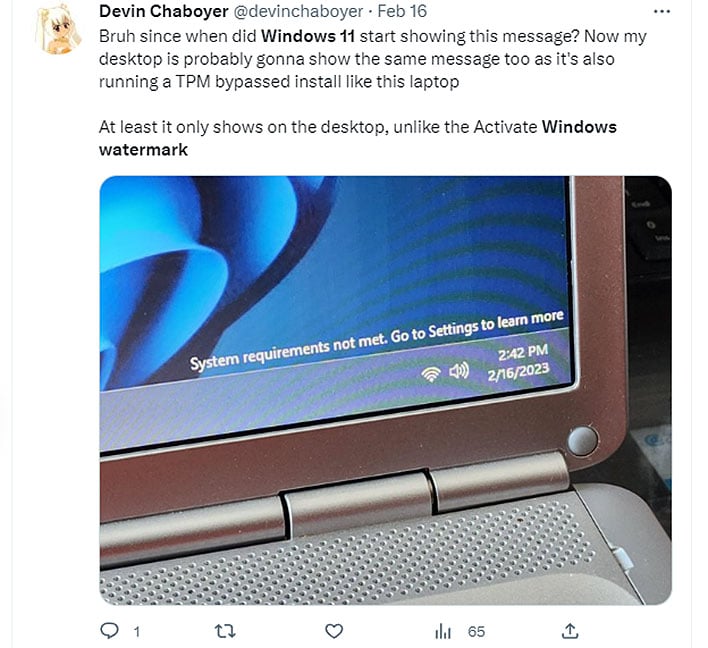One of the requirements to run Windows 11 is your PC is must be equipped with a
TPM (Trusted Platform Module) 2.0 security chip, and it also has to be enabled in the BIOS. You can get around this if you really want to, but in doing so, you may be forced to look at a watermark stating, "System requirements not met. Go to Settings to learn more." There's a way around this too, so long as you're comfortable mucking around the Registry.
Windows 11 users on Microsoft's support forum, Twitter, and elsewhere report that the Redmond software outfit has begun pushing out the annoying watermark on PCs that don't meet the OS's system requirements, whether it's because of the aforementioned TPM 2.0 chip or something else. It appears as white text in the lower-right corner, just above the taskbar.
Here's a look, courtesy of @devinchaboyer on Twitter...
The TPM 2.0 requirement means you need at least an 8th Gen Intel CPU (for the most part—some 7th Gen chips are supported) or 2nd Gen AMD processor. Other system requirements for Windows 11 include 4GB of RAM, 64GB of storage, UEFI supporting
Secure Boot, graphics that support DirectX 12 or later with a WDDM 2.0 driver, and at least a 9-inch display supporting 720p or higher.
None of those are especially stringent by today's standards, but they do potentially leave out some older PCs. The TPM 2.0 requirement is the biggest stumbling block and received a lot of attention when Windows 11 first came out. Assuming your PC supports the protocol, you can typically find the setting in your BIOS listed under one of several different names, some of which include AMD fTPM switch, AMD PSP fTPM, and Intel PTT (or Intel Platform Trust Technology).
Here's the thing—Microsoft's watermark is fair game, but where the ire comes into play is because it's permanent. As in, there's no obvious way to disable the watermark, either by right-clicking or navigating into settings. For users who follow the link, Microsoft says you "might want to consider purchasing a new PC" even though the one you're using is running perfectly fine.
Elsewhere, Microsoft's messaging is more alarming.
"This PC doesn't meet the minimum system requirements for running Windows 11 - these requirements help ensure a more reliable and higher quality experience. Installing Windows 11 on this PC is not recommended and may result in compatibility issues. If you proceed with installing Windows 11, your PC will no longer be supported and won't be entitled to receive updates. Damages to your PC due to lack of compatibility aren't covered under the manufacturer warranty,"
Microsoft states in a support document, and in bold text to boot.
Steps To Rid Your Unsupported Windows 11 PC From Microsoft's Watermark
What if you want to ignore Microsoft's scare tactics and run Windows 11 without the obnoxious watermark? Here's how to get rid of it...
- Click on the Start menu and type Registry Editor, then open it
- Expand HKEY_CURRENT_USER
- Navigate to and expand Control Panel
- Click the UnsupportedHardwareNotificationCache folder
- In the accompanying window pane, right-click the SV2 entry and select Modify
- Change the value to "0" then click OK
- Reboot your PC
Keep in mind that you can mess up your PC by making changes to your Registry, so don't go around deleting and editing entries willy-nilly. The above steps are safe, and at this point, Microsoft has not followed through on its threat to withhold updates from unsupported PCs. That's still a possibility though, so be aware of that as well.
If the only requirement you're missing is the TPM 2.0 switch, your best bet is to enable it in the BIOS. Otherwise, the above Registry hack should work to get rid of the watermark.



